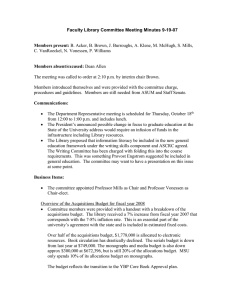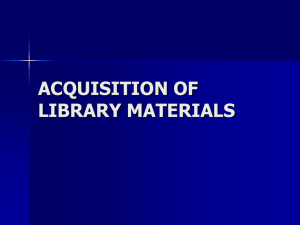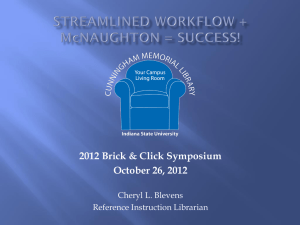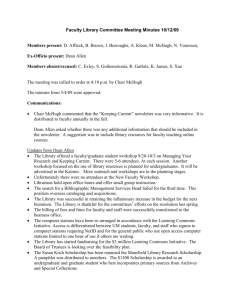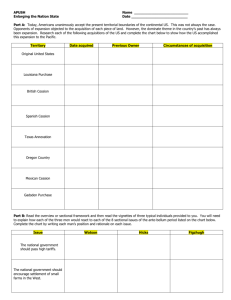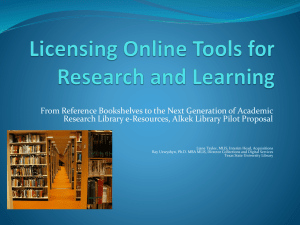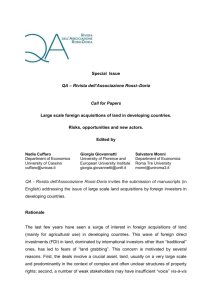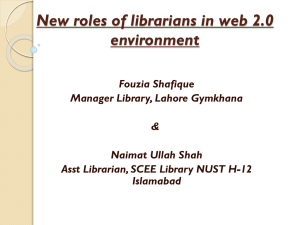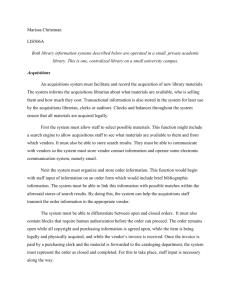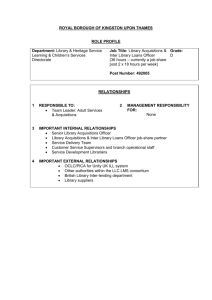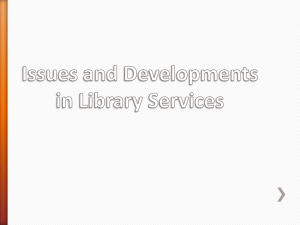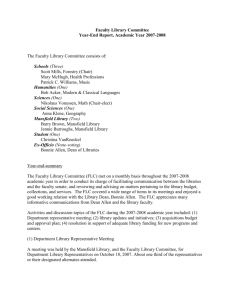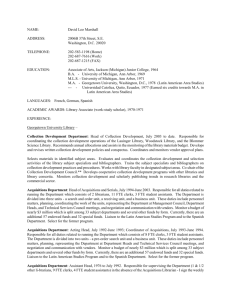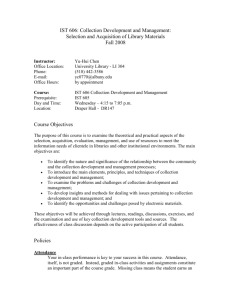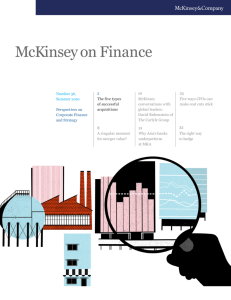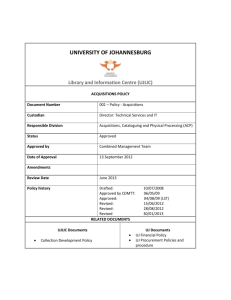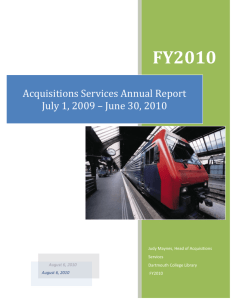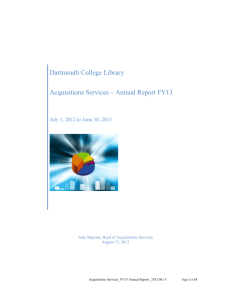AS O&M-Future of Acquisitions handout
advertisement
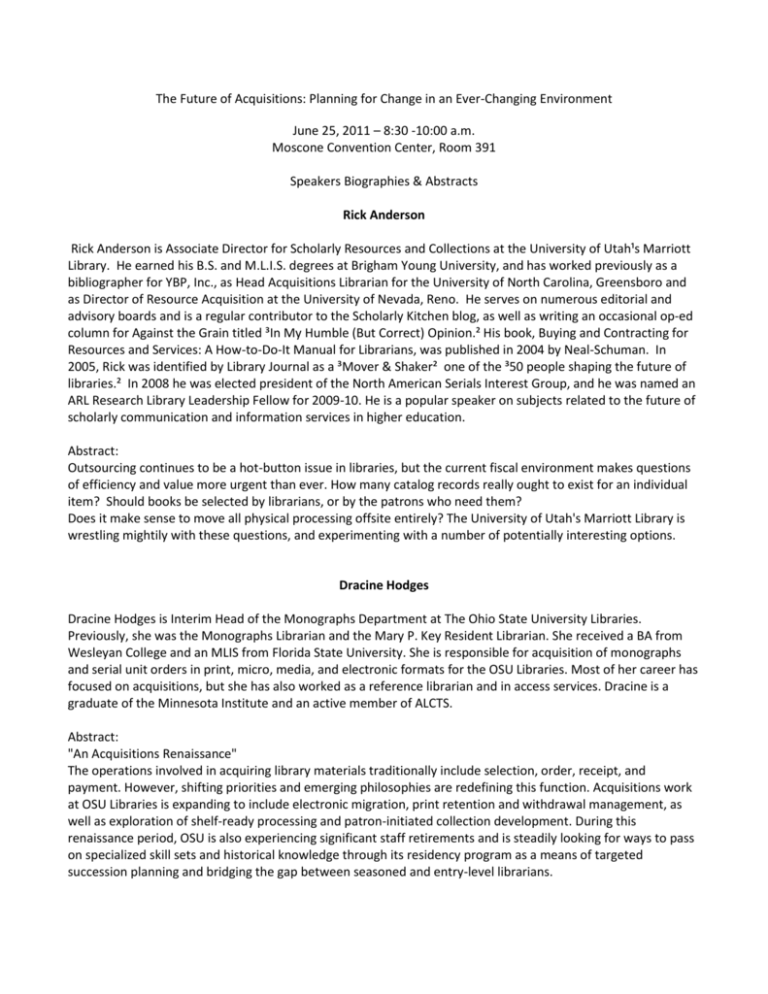
The Future of Acquisitions: Planning for Change in an Ever-Changing Environment June 25, 2011 – 8:30 -10:00 a.m. Moscone Convention Center, Room 391 Speakers Biographies & Abstracts Rick Anderson Rick Anderson is Associate Director for Scholarly Resources and Collections at the University of Utah¹s Marriott Library. He earned his B.S. and M.L.I.S. degrees at Brigham Young University, and has worked previously as a bibliographer for YBP, Inc., as Head Acquisitions Librarian for the University of North Carolina, Greensboro and as Director of Resource Acquisition at the University of Nevada, Reno. He serves on numerous editorial and advisory boards and is a regular contributor to the Scholarly Kitchen blog, as well as writing an occasional op-ed column for Against the Grain titled ³In My Humble (But Correct) Opinion.² His book, Buying and Contracting for Resources and Services: A How-to-Do-It Manual for Librarians, was published in 2004 by Neal-Schuman. In 2005, Rick was identified by Library Journal as a ³Mover & Shaker² one of the ³50 people shaping the future of libraries.² In 2008 he was elected president of the North American Serials Interest Group, and he was named an ARL Research Library Leadership Fellow for 2009-10. He is a popular speaker on subjects related to the future of scholarly communication and information services in higher education. Abstract: Outsourcing continues to be a hot-button issue in libraries, but the current fiscal environment makes questions of efficiency and value more urgent than ever. How many catalog records really ought to exist for an individual item? Should books be selected by librarians, or by the patrons who need them? Does it make sense to move all physical processing offsite entirely? The University of Utah's Marriott Library is wrestling mightily with these questions, and experimenting with a number of potentially interesting options. Dracine Hodges Dracine Hodges is Interim Head of the Monographs Department at The Ohio State University Libraries. Previously, she was the Monographs Librarian and the Mary P. Key Resident Librarian. She received a BA from Wesleyan College and an MLIS from Florida State University. She is responsible for acquisition of monographs and serial unit orders in print, micro, media, and electronic formats for the OSU Libraries. Most of her career has focused on acquisitions, but she has also worked as a reference librarian and in access services. Dracine is a graduate of the Minnesota Institute and an active member of ALCTS. Abstract: "An Acquisitions Renaissance" The operations involved in acquiring library materials traditionally include selection, order, receipt, and payment. However, shifting priorities and emerging philosophies are redefining this function. Acquisitions work at OSU Libraries is expanding to include electronic migration, print retention and withdrawal management, as well as exploration of shelf-ready processing and patron-initiated collection development. During this renaissance period, OSU is also experiencing significant staff retirements and is steadily looking for ways to pass on specialized skill sets and historical knowledge through its residency program as a means of targeted succession planning and bridging the gap between seasoned and entry-level librarians. Pam Matthews Pam Matthews, the Acquisitions Manager at Cuyahoga County Public Library, has been working in library acquisitions since 1986, when she started as an undergraduate student worker. Although she had some brief detours (once into public service and once to the dark side, working for a vendor), for most of her career Pam has stayed involved in acquisitions, both in academic and public libraries. Abstract: "Doing More Stuff with Less Staff" CCPL orders an average of about 11,000 items a week. After some reductions in force, the department was left with only one order entry clerk and four receiving assistants. With new employees and a new acquisitions manager, the department had an optimal chance to eliminate duplicate processes, work more closely with other technical services departments, and reshape vendor relationships to make sure Items are ordered, received, and released to the public as quickly as possible. This hand-out may also be found at http://connect.ala.org/node/64085

